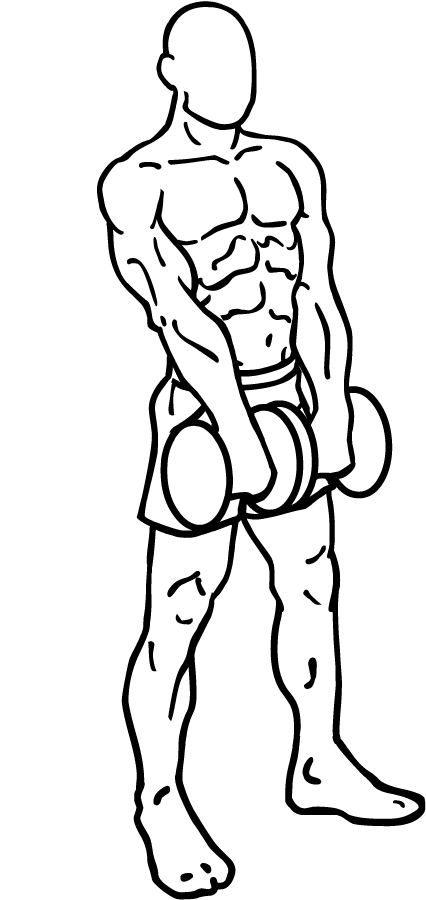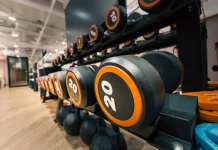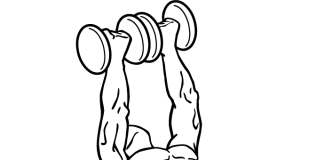Last Updated on September 30, 2014
The Dumbbell Upright Rows is a highly effective exercise that targets multiple upper body muscles, specifically the shoulders, biceps, and upper back. This movement is particularly beneficial for building strength, enhancing muscle definition, and improving shoulder stability. It’s a simple yet powerful exercise that can be incorporated into various workout routines, whether you’re a beginner or an experienced lifter looking to add variety to your shoulder and upper body training.
In this comprehensive guide, we’ll cover everything you need to know about the Dumbbell Upright Row, from its benefits and proper execution to common mistakes and variations. By the end of this post, you’ll have all the knowledge necessary to master this exercise and start seeing real results.
Why Should You Do Dumbbell Upright Rows?
The Dumbbell Upright Rows is a compound exercise, which means it works multiple muscle groups simultaneously. This makes it an efficient and effective way to develop strength and muscle mass in your shoulders, biceps, and upper back. Here are some key reasons to include this exercise in your routine:
- Targets Key Upper Body Muscles: The Dumbbell Upright Rows primarily works the deltoids (shoulders), biceps, and trapezius muscles (upper back). These muscle groups are crucial for overall upper body strength, posture, and aesthetics. Strengthening them can also improve your performance in other exercises like the bench press and overhead press.
- Enhances Shoulder Stability: By engaging the shoulder muscles, this exercise helps improve shoulder stability, reducing the risk of injury during other upper body movements. It also helps you develop better control over your shoulder joint, which is essential for any athlete or gym-goer.
- Improves Posture: A strong upper back and well-developed shoulders can help improve your posture by pulling your shoulder blades back and preventing slouching. The Dumbbell Upright Row is especially useful for those who spend a lot of time sitting at a desk or working on a computer, as it helps correct rounded shoulders.
- Builds Aesthetic Upper Body Definition: If you’re looking to develop that “V-shape” upper body, the Dumbbell Upright Row is an excellent exercise to add to your workout. By targeting the deltoids and trapezius, it contributes to broader, more defined shoulders and an overall more balanced upper body.
- Versatile and Accessible: The Dumbbell Upright Rows requires minimal equipment—just a pair of dumbbells—making it easy to perform whether you’re in the gym or working out at home. Plus, it’s suitable for all fitness levels, as you can adjust the weight to match your strength and ability.
Muscles Worked in the Dumbbell Upright Row
The Dumbbell Upright Rows is a compound exercise that works several upper body muscles at once, giving you a highly effective workout in just one movement. Here’s a breakdown of the primary muscle groups involved:
- Deltoids (Shoulders): The deltoids are the main muscles targeted in the Dumbbell Upright Rows. Specifically, the anterior (front) and lateral (side) deltoids are engaged as you lift the dumbbells towards your shoulders. Developing these muscles helps create broader, more defined shoulders.
- Trapezius (Upper Back): The trapezius muscles, which span the upper part of your back and neck, are heavily involved in this movement. They help lift your shoulder blades as you raise the dumbbells, which not only strengthens the upper back but also improves posture.
- Biceps: The biceps are engaged as secondary muscles during the pulling motion, particularly when you bend your elbows to lift the dumbbells. This adds an element of arm strengthening to the exercise, making it a great upper body movement overall.
- Rhomboids (Upper Back): The rhomboid muscles, located between your shoulder blades, are also activated when you rotate your shoulder blades together at the top of the movement. This helps improve back strength and stability.
- Core Muscles: While the Dumbbell Upright Row is primarily an upper body exercise, your core muscles are also engaged to help stabilize your body and maintain proper posture throughout the movement.
Step-by-Step Guide to Performing the Dumbbell Upright Row
Equipment Needed:
- Two dumbbells: Start with a manageable weight that allows you to maintain control throughout the exercise. You can increase the weight as you become more comfortable with the movement.
Starting Position:
- Grasp the Dumbbells: Begin by standing with your feet shoulder-width apart and holding a dumbbell in each hand with an overhand grip (palms facing down). The dumbbells should be resting in front of your thighs, with your arms fully extended.
- Engage Your Core: Draw your abs in to stabilize your torso and maintain a straight posture. This is important for preventing lower back strain during the exercise.
- Back Straight and Chest Up: Ensure that your back is straight and your chest is lifted to avoid rounding your shoulders forward. Keeping good posture is key to performing this exercise safely and effectively.
The Movement:
- Lift the Dumbbells: Slowly lift the dumbbells towards your shoulders by bending your elbows and raising them upwards. Keep your elbows higher than your forearms as you pull the weights close to your body. The movement should resemble a rowing motion.
- Pause at the Top: When the dumbbells reach shoulder height, pause for a moment and squeeze your shoulder blades together. This contraction will engage your upper back muscles and help build strength in this area.
- Lower the Dumbbells: After pausing at the top, lower the dumbbells back to the starting position in a controlled manner. Resist the urge to let gravity do the work—lowering the weights slowly helps maximize muscle activation and prevents injury.
- Repeat: Perform the exercise for 8–12 repetitions, depending on your fitness level and the weight you’re using. Aim for 3–4 sets to fully engage the muscles and build strength.
Tips for Proper Form and Avoiding Injury
- Keep the Dumbbells Close to Your Body: Throughout the movement, the dumbbells should remain close to your torso. Allowing them to drift too far forward can place unnecessary stress on your shoulders and elbows, increasing the risk of injury.
- Do Not Arch Your Back: As you lift the dumbbells, avoid arching your back. This can cause strain on your lower back and reduce the effectiveness of the exercise. Instead, engage your core and keep your spine neutral.
- Elbows Higher Than Forearms: One of the key aspects of the Dumbbell Upright Row is keeping your elbows higher than your forearms as you lift the weights. This ensures proper shoulder engagement and helps prevent elbow strain.
- Use Controlled Movements: Avoid jerky or fast motions. Lifting and lowering the dumbbells in a controlled manner will not only make the exercise more effective but also reduce the risk of injury.
- Avoid If You Have Joint Pain: If you experience wrist, shoulder, or elbow pain, it’s best to avoid the Dumbbell Upright Row. There are alternative exercises that can target similar muscle groups without putting strain on these joints.
Variations of the Dumbbell Upright Row
To keep your workouts challenging and prevent plateaus, consider incorporating some of these variations of the Dumbbell Upright Row:
- Barbell Upright Rows: Instead of using dumbbells, you can perform this exercise with a barbell. The barbell version allows for heavier weights, making it ideal for those looking to build maximum strength in the shoulders and upper back.
- Single-Arm Dumbbell Upright Row: This variation involves lifting one dumbbell at a time. It helps improve balance and coordination while targeting the same muscle groups.
- Kettlebell Upright Row: Using kettlebells instead of dumbbells can add a new dimension to the exercise. The unique shape of kettlebells requires more stabilization, which engages additional muscles, particularly in the core.
- Resistance Band Upright Row: If you don’t have access to dumbbells, a resistance band can be used for this exercise. Stand on the band and pull it towards your shoulders as you would with dumbbells. This variation is great for at-home workouts or those looking to add variety to their routine.
Common Mistakes to Avoid
While the Dumbbell Upright Row is relatively simple, there are a few common mistakes to watch out for:
- Lifting Too Heavy: Using weights that are too heavy can lead to poor form, such as arching your back or swinging the dumbbells. Always choose a weight that allows you to perform the exercise with control and proper technique.
- Not Engaging the Core: Failing to engage your core can result in instability and poor posture during the exercise. Keep your abs tight throughout the movement to maintain a strong and stable base.
- Locking Your Elbows: Fully extending your arms at the bottom of the movement is important, but be careful not to lock your elbows. This can place unnecessary stress on the joints and increase the risk of injury.
- Rushing the Movement: Speeding through the exercise reduces muscle engagement and increases the likelihood of injury. Focus on slow, controlled movements to get the most out of each repetition.
How to Incorporate Dumbbell Upright Rows into Your Routine
The Dumbbell Upright Row is a versatile exercise that can be incorporated into a variety of workout routines. Here are a few ways to include it:
- Shoulder Day: On days when you’re focusing on shoulder development, the Dumbbell Upright Rows should be one of your key exercises. Pair it with other shoulder-specific movements like lateral raises and overhead presses for a comprehensive shoulder workout.
- Upper Body Workouts: Incorporating Dumbbell Upright Rows into your upper body workouts is a great way to target multiple muscle groups simultaneously. Combine it with exercises like bench presses, push-ups, and rows to ensure a well-rounded upper body session that engages your shoulders, chest, and back.
- Full-Body Workouts: In full-body workout routines, the Dumbbell Upright Rows can be used to strengthen the shoulders, biceps, and upper back while working alongside other compound exercises like squats and deadlifts. This makes it an efficient addition to routines aimed at hitting all major muscle groups in one session.
- Supersets: To add intensity to your workout, consider pairing Dumbbell Upright Rows with another upper body exercise in a superset. For example, you can perform Upright Rows followed immediately by lateral raises or tricep dips, giving your upper body muscles minimal rest and increasing muscle endurance.
- Warm-Up or Finisher: The Dumbbell Upright Rows can be used as a warm-up exercise to get your shoulder and upper back muscles activated before heavier lifts. Alternatively, you can use it as a finisher towards the end of your workout to fully exhaust your shoulder and upper body muscles, ensuring that you’ve targeted them completely before wrapping up your session.
Sample Dumbbell Upright Row Workout
Here’s a sample workout incorporating Dumbbell Upright Rows into a shoulder-focused routine:
- Warm-Up: 5–10 minutes of light cardio (e.g., cycling or jumping jacks) and dynamic stretching
- Overhead Press: 3 sets of 10–12 reps
- Dumbbell Upright Row: 4 sets of 8–12 reps
- Lateral Raises: 3 sets of 12–15 reps
- Bent-Over Reverse Flyes: 3 sets of 10–12 reps
- Dumbbell Shrugs: 3 sets of 12–15 reps
- Cool Down: Static stretching, focusing on the shoulders and upper back
Benefits of Consistent Dumbbell Upright Rows Training
When performed regularly and with proper form, the Dumbbell Upright Row provides a range of benefits for your strength training routine:
- Increased Shoulder Strength: The primary benefit of Dumbbell Upright Rows is the development of stronger shoulders. With consistent practice, you’ll notice an improvement in your ability to perform other shoulder-related exercises such as push presses and lateral raises.
- Enhanced Upper Back and Trap Definition: By focusing on the trapezius muscles, this exercise helps you achieve a more defined upper back, contributing to the aesthetic “V-shape” look.
- Better Posture: Since this exercise engages the upper back and shoulders, it promotes better posture by pulling the shoulders back and improving shoulder blade mobility. This is especially beneficial for those who spend long hours sitting at a desk or hunching over a computer.
- Balanced Upper Body Development: The Dumbbell Upright Row effectively targets the shoulders and upper back while engaging the biceps as a secondary muscle group. This balanced approach ensures that your upper body develops in harmony, reducing the risk of muscle imbalances that could lead to injury.
- Improved Grip and Arm Strength: Holding onto the dumbbells throughout the exercise requires you to engage your forearm muscles and improve your grip strength, which can translate to improved performance in other exercises like deadlifts, pull-ups, and rows.
The Dumbbell Upright Rows is a versatile and powerful exercise that should be a staple in any upper body workout routine. Whether you’re aiming to build stronger shoulders, improve posture, or enhance upper back and bicep definition, this exercise delivers results. Its simplicity makes it accessible to beginners, while its effectiveness keeps even seasoned lifters coming back for more.
As with any exercise, mastering proper form is key to unlocking the full benefits of the Dumbbell Upright Rows. Start with lighter weights, focus on controlled movements, and gradually increase the load as you get stronger. Remember to avoid common mistakes like arching your back or using excessive momentum, as this can diminish the effectiveness of the exercise and lead to injury.
By incorporating the Dumbbell Upright Rows into your workout routine, you’ll be well on your way to building a stronger, more defined upper body. Whether you use it as part of a shoulder day, in a full-body workout, or as a finishing move, this exercise will help you achieve your fitness goals and improve your overall strength. Stay consistent, pay attention to your form, and watch your shoulders and upper body transform over time.
So grab those dumbbells, focus on your posture, and start rowing your way to stronger shoulders, arms, and upper back.








